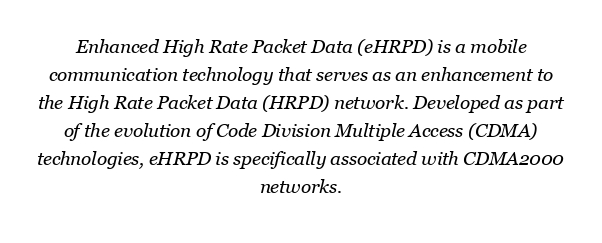
What is eHRPD Network?
eHRPD stands for evolved High Rate Packet Data. It is a network architecture developed to provide a smooth migration path between CDMA-based networks and LTE (Long Term Evolution) networks. Specifically, eHRPD is an evolution of the HRPD (High Rate Packet Data) system, also known as EV-DO (Evolution-Data Optimized), and it enables interoperability between legacy 3G networks and newer 4G LTE systems. The purpose of eHRPD is to allow mobile operators to offer continuous service and seamless data session transitions as users move between 3G and 4G coverage areas.
Unlike traditional EV-DO networks, which were independent of LTE, eHRPD introduces enhancements to align the packet core with LTE’s Evolved Packet Core (EPC). This alignment allows for faster handoffs, better session continuity, and more efficient use of network resources. eHRPD enables users to initiate data sessions in LTE and maintain those sessions even as they fall back to a CDMA-based environment, reducing dropped connections and improving user experience.
Key Components of an eHRPD Network
eHRPD is built upon the existing EV-DO network but with modified architecture to integrate with the LTE core. The main components include:
- Access Network: This consists of the eHRPD Radio Access Network (RAN), which includes the modified Base Transceiver Stations (BTS) and Access Network Controllers (ANC) capable of supporting evolved functionality.
- Access Network Gateway (ANGW): A gateway that connects the RAN to the LTE core network. It supports the S2a interface used in the EPC.
- Evolved Packet Core (EPC): The LTE core that handles session management, mobility, and data routing. eHRPD networks use this core instead of the older PDSN (Packet Data Serving Node).
By using the S2a interface and integrating with the LTE core, eHRPD enables mobile data sessions to be managed centrally, which improves consistency and control over service quality. This also simplifies the transition for network operators moving toward all-IP LTE networks.
Comparison Between HRPD and eHRPD
| Feature | HRPD (EV-DO) | eHRPD |
|---|---|---|
| Core Network | Legacy CDMA Core (PDSN) | LTE Evolved Packet Core (EPC) |
| Mobility with LTE | Limited or not supported | Seamless interworking with LTE |
| Session Continuity | Broken during handoffs | Maintained across LTE/eHRPD |
| Latency | Higher | Lower, optimized path |
| QoS Control | Basic | Aligned with LTE QoS |
The table shows that eHRPD is a significant improvement over traditional HRPD in terms of integration, performance, and continuity, especially in mixed 3G/4G environments.
Why is eHRPD necessary if LTE exists?
eHRPD provides a necessary bridge between 3G and LTE networks. In many regions, LTE coverage may not be universal or consistent, and users may frequently move between areas of 4G and 3G coverage. eHRPD allows devices to maintain an active data session while transitioning between LTE and 3G networks. Without eHRPD, users might experience dropped connections or need to reinitiate their sessions during handoffs, leading to poor user experience.
Can eHRPD improve data speed?
eHRPD itself does not necessarily increase the peak data speed over traditional EV-DO Rev. A or Rev. B; the radio interface remains similar. However, it optimizes session management, reduces latency, and enhances data flow efficiency by connecting to the EPC. These optimizations result in faster perceived performance and better responsiveness in data-intensive applications.
Is eHRPD used for voice calls?
No, eHRPD is a data-only technology. Voice services in CDMA networks typically use circuit-switched infrastructure. In mixed networks, voice is often managed using Circuit Switched Fallback (CSFB) or VoLTE (Voice over LTE) when on LTE. eHRPD focuses solely on improving mobile broadband experience across network transitions.
How does eHRPD support handoffs between LTE and CDMA?
When a mobile device using LTE moves into an area with only CDMA coverage, eHRPD facilitates a seamless handoff by maintaining the data session through the EPC. The S2a bearer is preserved during the transition, and the network switches to the eHRPD access path without requiring the user to reconnect or experience service interruption. This is known as Single Radio Voice Call Continuity (SRVCC) for voice and seamless fallback for data.
Which devices support eHRPD?
Most dual-mode devices (those that support both CDMA and LTE) are designed with eHRPD compatibility. These include smartphones, mobile hotspots, and modems. The support is typically built into the baseband firmware and controlled by the carrier’s configuration. If a network operator supports eHRPD, the device will automatically utilize it when appropriate.
eHRPD is a critical transition technology that allows network operators to move towards LTE without abandoning their existing 3G infrastructure. It enhances service continuity, reduces latency, and ensures a consistent data experience for users traveling between network technologies. Though eHRPD is not a long-term solution in the era of fully deployed LTE and 5G, it has played a crucial role in supporting hybrid networks during the evolution of mobile broadband.